Discovering Beach Shacks and Kiteboarding in Puerto Rico
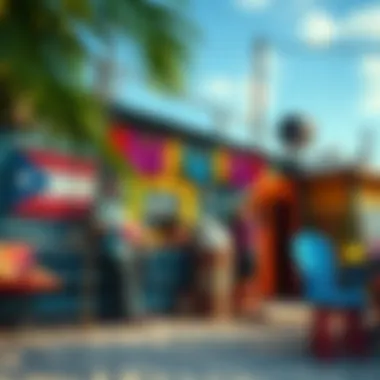

Intro
The coastline of Puerto Rico is like a treasure map of vibrant experiences, with beach shacks dotting the shores. These shacks are not just structures made of wood and thatch; they represent a unique slice of Puerto Rican culture. The smell of fried fish and sweet plantains wafts through the air, beckoning local and travelers alike. Each shack has its own character, telling stories of generations that have come before.
In this article, we will dive headfirst into the charm of these coastal havens. You might be wondering what makes them so compelling. Well, they serve not only as food joints but also as gathering places for kiteboarders riding the waves. It's a haven for adventure seekers who are drawn to the sea, whether for a serious training session or just fun. An ideal blend of flavor, culture, and action awaits those willing to explore this lesser-known aspect of the island.
Let’s embark on this journey, highlighting some of the shacks worth a visit, the local flavors that excite the palate, and the tight-knit community that kiteboarding fosters. This exploration isn’t just about the shacks themselves, but also about how they connect us all — through food, sports, and the sun-soaked beauty of the Puerto Rican coast.
Prelims to Puerto Rico's Beach Culture
Puerto Rico is not just an island; it's a reflection of a lifestyle intertwined with the rhythm of the ocean. Its beaches are more than stretches of sand; they are vibrant hubs of activity, culture, and community. This section lays the groundwork for understanding how the beach culture forms a significant part of Puerto Rican identity. From the locals who gather each weekend to savor the sun to the shoreline establishments that serve them, beaches are the heartbeats of coastal life.
Geographical Overview of Puerto Rico
Nestled in the northeast Caribbean, Puerto Rico's geographical advantages are staggering. The island spans approximately 100 miles long and 35 miles wide, offering a diverse array of beach settings. From the windswept shores of Rincon on the west to the picturesque sands of Luquillo in the east, the island cradles over 270 miles of coastline. The charm is amplified with lush mountainous areas just a stone's throw away from crystal-clear waters.
Beaches like Flamenco Beach on Culebra rank among the best globally, while local favorites might be tucked away in small coves or in the shadow of towering cliffs.
"Puerto Rico's beaches are like a treasure chest - each wave reveals something unique."
This geographical variety not only beautifies the scenery but also supports multiple water sports, including kiteboarding, surfing, and paddleboarding, making it a paradise for thrill-seekers and all types of beach enthusiasts.
Role of Beaches in Puerto Rican Lifestyle
In Puerto Rico, the beach is both an escape and a way of life. For the local populace, beaches serve multiple functions. Families often gather for weekends filled with laughter, grilling snacks, and enjoying the ocean breeze. The shoreline becomes an extension of their homes, where memories of childhood summers and family gatherings are etched into the sands forever.
Moreover, beaches in Puerto Rico are catalysts for economic activity. From food vendors to artisan markets, the coastal areas support a myriad of local businesses, most notably the much-loved beach shacks. These shacks provide both sustenance and a space for social interaction, blending culinary traditions with familial connections and community spirit. They often evolve into landmarks, where regulars gather, sharing stories and forming bonds that outlast mere visits.
In summary, Puerto Rico's beach culture is a rich tapestry woven from its stunning geography and the lifestyle it promotes. The beaches not only offer solace and recreation but also act as centers for social interaction and economic vitality, pivotal in shaping the identity of the island.
Defining Beach Shacks
Understanding the essence of beach shacks is essential to grasp the unique atmosphere of Puerto Rico's coastal lifestyle. These humble structures are more than mere shanties by the water's edge; they embody a vibrant culture, a connection to the ocean, and a lifestyle deeply rooted in the rhythm of the tides. Picture this: a wooden shack, with peeling paint and a tin roof, where locals gather to chat, share stories, and indulge in freshly caught seafood.
Beach shacks are integral to the daily lives of Puerto Ricans. They serve a multitude of purposes, from eateries offering favorite local dishes to informal gathering spots where relaxation reigns supreme. The benefits of these shacks extend beyond their culinary offerings; they foster community, provide jobs, and keep local traditions alive. As the sun sets, the shacks transform into lively spots, buzzing with laughter and the sizzling sounds of food preparations.
Cultural Significance of Beach Shacks
The cultural significance of beach shacks in Puerto Rico runs deep. These establishments are a staple of coastal life, often reflecting the history and heritage of the communities they serve. They are places where the spirit of the island’s culture flourishes. When you step into a beach shack, you are stepping into a microcosm of Puerto Rican hospitality. Locals take pride in their shacks, often passed down through generations, and this lineage adds layers to their stories.
Moreover, these shacks create an inviting atmosphere that welcomes both residents and tourists. The casual setting encourages connections, and it’s not uncommon to see patrons sharing a table, bringing together strangers from different walks of life. With each delicious meal, you get a taste of local flavors and an insight into the culture that shapes Puerto Rico.
Varieties of Beach Shacks
Puerto Rico boasts an array of beach shacks, each distinct in character and offerings. The variety ranges from simple wooden structures with minimal amenities to well-equipped establishments that cater to tourists looking for a comprehensive experience. Some beach shacks focus solely on food, while others may offer skateboards, kiteboarding gear, or even art crafted by local artists.
There are essentially two broad categories: the traditional shacks, often found in less commercialized areas, and those that cater to the tourist circuit, providing a broader range of services and amenities.
- Traditional Shacks: These shacks often serve as local hangouts, where people gather for a delicious plate of "mofongo" or grilled fish. Often family-owned, they exude authenticity and warmth.
- Tourist-Oriented Shacks: These might have a slightly different flair, with menus designed to introduce visitors to Puerto Rican cuisine while also providing a lively backdrop for sun-soaked afternoons. Their decor might feature colorful murals and other eye-catching designs that capture the essence of island life.
Gastronomy of Puerto Rican Beach Shacks
When it comes to the identity of Puerto Rican beach culture, gastronomy plays a major role. The shacks on the beach do not merely serve food; they offer a culinary journey that intertwines local flavors, traditions, and the delicious variety of ingredients found across the island. This vibrant food scene is a focal point for both locals and tourists, creating memorable experiences that enhance their time spent in the sun and surf.
Local Dishes and Ingredients
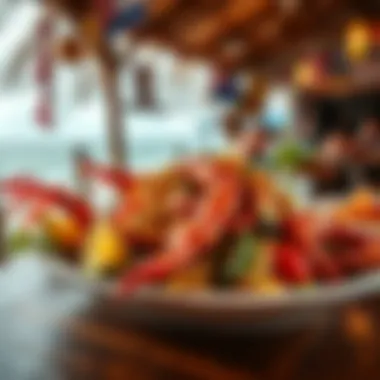
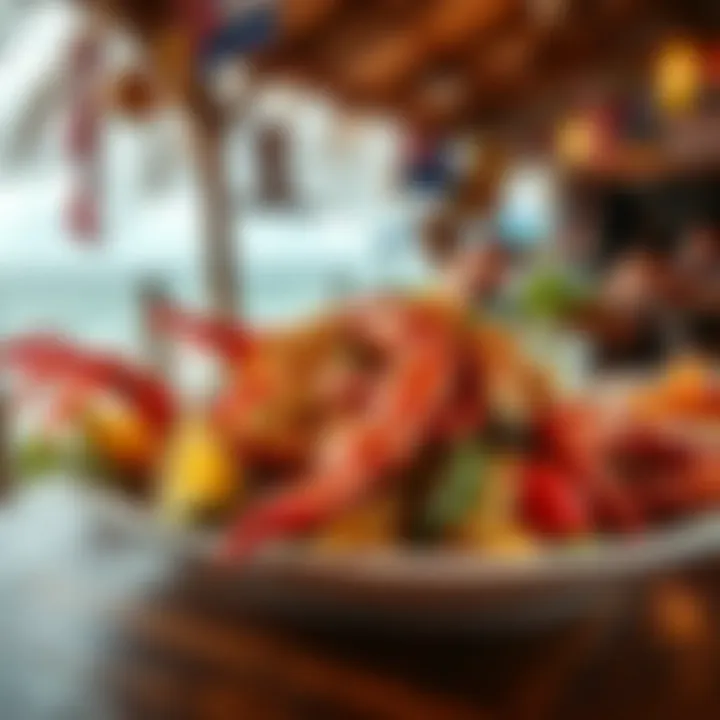
In the realm of Puerto Rico’s beach shacks, food isn't just fuel; it’s a tradition waving like a flag in the salty breeze. Commonly found dishes include mofongo, a delightful mix of mashed plantains often paired with seafood or chicken. The use of frying pans and fire pits at these shacks adds an authentic touch to the gastronomical offerings. Fresh fish, like tuna and dorado, is abundant, and is frequently prepared right in front of the customers.
Customers might find themselves enjoying a plate of tostones (twice-fried green plantains) next to the shimmering sea, as the smell of garlic and lime wafts through the air. Other staples include empanadillas, which are savory turnovers filled with seasonal ingredients, and fish fillet served with a mango salsa that brings the sweet and savory balance of the tropics directly to the palate.
Local ingredients play an important part in these dishes. Developments in sustainable fishing and local agriculture have encouraged shack owners to source produce like avocados, peppers, and coconuts from nearby farms and suppliers. This draws a direct line from the land and sea to the plate—providing not only fresh and tasty food but also supporting the local economy.
Influence of Coastal Cuisine
The coastal cuisine found in Puerto Rican beach shacks is rich not just in flavor, but in cultural history. This pizza of tastes is seasoned with the stories of the island’s past, including influences from the Taíno, African, and Spanish ancestry. Through this blend, local dishes have evolved, showcasing a fusion that is a feast for both the eyes and the tastebuds.
Visitors often uncover that the gastronomic experience at a beach shack goes beyond what one eats; it’s a shared moment of laughter and conversation while savouring a rich, fulfilling meal. The shack's cuisine reflects an unwritten communal agreement: when you’re here, you’re family.
Culinary events are an integral part of the beach culture. Shack owners may host seasonal festivals where local chefs whip up unique dishes, helping promote regional ingredients. These events foster a sense of community among food lovers and provide an opportunity for small businesses to shine.
"In a place where the sun shines brightly and the tides ebb and flow, the food found at a beach shack becomes a window into the island's soul."
In summary, the gastronomy of Puerto Rican beach shacks is a signature component of the culture. With local dishes rich in flavor, influence, and community ties, it is clear that this culinary exploration is an integral part of the Puerto Rican experience, waiting to be savored by every adventurer who graces the shores.
Popular Shacks to Visit
The essence of Puerto Rico's coastal charm is often distilled into its beach shacks. These humble establishments not only offer a taste of local flavors but also serve as social hubs for kiteboarders, surfers, and leisure seekers alike. They encapsulate the spirit of the island, bridging the gap between luxurious waters and a casual vibe. This section is pivotal as it helps the reader navigate through diverse culinary experiences while uncovering the cultural nuances that each shack embodies.
East Coast: A Culinary Paradise
Along the East Coast, beach shacks like Hurricane Grill and El Balneario sit prominently, luring in visitors with the promise of freshly caught seafood and grilling delights. The salty ocean breeze complements the tangy flavors of authentic dishes such as mofongo stuffed with shrimp or tostones served with a spicy garlic dip. Here, the atmosphere is lively, frequented by locals and travelers alike, creating a vibrant tapestry of camaraderie.
Seats are often a premium, especially during sunset, as people gather to indulge in the culinary offerings while watching the sky ablaze with hues of orange and pink. It’s a sight to behold, turning a simple meal into a spectacle. The East Coast thrives on community events, often organized around kiteboarding competitions, drawing even more guests into these beloved shacks. Such events not only showcase the sport but also foster relationships among enthusiasts.
West Coast: Hidden Gems
The West Coast offers a different allure with lesser-known shacks like La Pared and Pico de Gallo. These spots might not come with the usual fanfare, yet they hold treasures waiting to be discovered. Rustic charm and unmatched flavors are the hallmarks here. Visitors can find unique dishes that reflect the region's influence from various tropical ingredients.
Picture yourself seated at a wooden table, enjoying a plate of grilled fish seasoned with local spices, all while being serenaded by the rhythmic sound of waves crashing nearby. Each shack carries individual stories and connections to the communities that sustain them, making discovery all the more rewarding. Don't shy away from the off-menu specials; local chefs often whip up hidden gems that perfectly reflect the essence of Puerto Rican culinary art.
North Coast: Vibrant Beach Scene
Heading to the North Coast, you find a flourishing beach culture exemplified by shacks like Kite Beach Shack. This place pulses with energy, particularly during the kiteboarding season when the winds are just right. Shacks here cater primarily to the adventurous crowd, offering quick bites that can be enjoyed on-the-go, such as arepas stuffed with savory fillings and refreshing tropical smoothies.
The vibrant scene is complemented by an array of watersports, with kiteboarders often taking breaks between sessions to swap stories or exchange tips over a meal. It’s this synchronization of activity and relaxation that makes the North Coast an irresistible destination for thrill-seekers. Living the moment is what it’s all about, and the North Coast shacks provide the perfect perch.
South Coast: Relaxed Atmosphere
On the South Coast, shacks like Cayo Caracoles and Playa Los Rieles create a laid-back beachfront atmosphere. Here, the pace slows, allowing visitors to unwind and enjoy the simple pleasures of life. Fresh fruit cocktails and slow-cooked local stews come highly recommended. The vibe is less hurried, lending itself well to leisurely afternoons spent lounging at the beach or napping in a hammock.
Exploring the coastline from these shacks reveals secluded coves and tranquil waters—a perfect backdrop for recreational activities or simply soaking up some sun. Seasoned locals offer tales about the area over meals, fostering a sense of connection to the land and appreciation for the waves that have shaped it.
"Beach shacks are the heartbeats of Puerto Rico's coastal culture, where food and community intertwine seamlessly."
In summary, each beach shack across Puerto Rico’s coasts creates an opportunity for discovery, connection, and celebration of local culture. They are the meeting points for culinary adventures and sports experiences, making them an essential part of any coastal exploration.
Beach Shack Experience
The beach shack experience in Puerto Rico extends well beyond just eating local fare while gazing at the waves. It represents a unique intersection of community, culture, and nature. For many individuals—especially kiteboarders and adventure lovers—these shacks serve as slivers of paradise where friends gather, acquaintances turn into family, and memories are made against the backdrop of sun, sea, and sand. The experience is shaped by multiple factors, from the ambiance and the local crowd to the action of kiteboarding.
Ambiance and Atmosphere
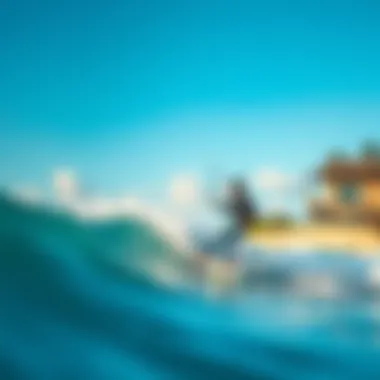
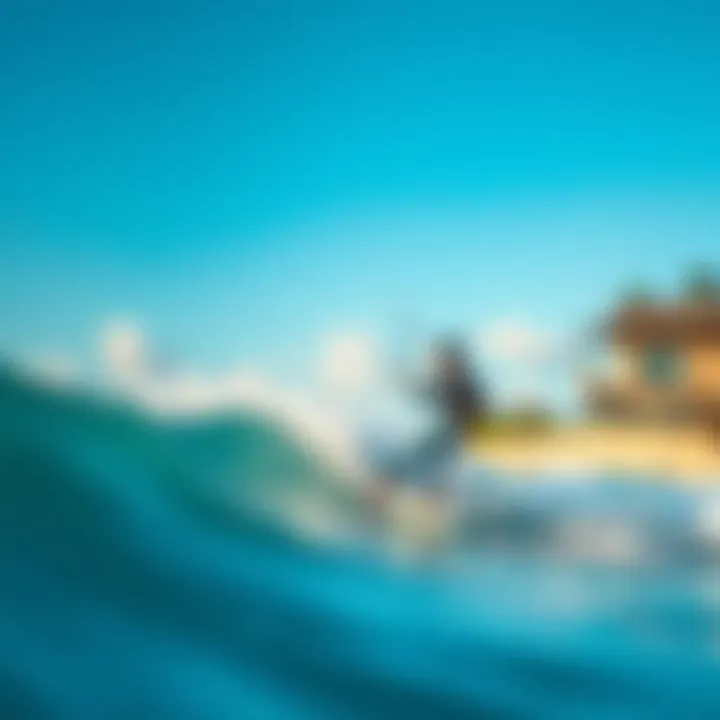
The ambiance of a beach shack is truly one-of-a-kind. Picture this: the sound of waves crashing, local musicians strumming under a palm tree, and that irresistible smell of freshly grilled fish wafting through the air. Shacks like La Pared in Luquillo have perfected this atmosphere, fostering a laid-back vibe that draws people in.
Typically painted in vibrant colors, each shack tells its own stories through murals or quirky decorations. This isn't just a place to grab a bite; it’s a cozy invitation to unwind. The simplicity of wooden tables adorned with seashells reflects an authentic beach charm that modern establishments often overlook. In these environments, the outside world feels a million miles away.
Furthermore, when kiteboarders flock to these shacks, they bring with them tales of their adventures on the water. You might hear about a recent navigation through challenging winds or the thrill of mastering a new trick. This exchange shapes the atmosphere into an enticing melting pot of excitement and shared experiences.
Social Interaction and Community
Social interaction is at the heart of the beach shack experience. It’s common to see strangers strike up conversations, discussing everything from world travels to local kiteboarding spots. For many, especially those who come from far-off lands, these shacks transcend mere dining establishments. They become hubs of connection, bridging diverse backgrounds through a mutual love for the sea and adventure.
Here’s the beauty: the shacks often operate as informal meeting points where locals and tourists mingle alike. This community aspect of the beach shack experience fosters a spirit of hospitality that is deeply rooted in Puerto Rican culture.
"Every time I visit a shack, I make new friends—each time bringing fresh stories and smiles."
In addition, while kiteboarding naturally thrives on adrenaline and competition, beach shacks create an inclusive environment where all levels of enthusiasm—be it a seasoned boarder or someone just picking up the sport—can feel at home. The bonds formed over shared meals, laughter, and camaraderie affirm that these shacks play an essential role in fostering a sense of belonging among adventurers and locals alike.
To sum it up, the beach shack experience in Puerto Rico is layered and intricate. It is not just about savoring local delicacies or enjoying gorgeous views—it's about cultivating relationships and being part of a thriving coastal community that values both its heritage and the joy of kiteboarding. The elements at play in this unique atmosphere are what make the experience unforgettable.
Kiteboarding in Puerto Rico
Kiteboarding holds a special place in the hearts of both locals and visitors to Puerto Rico. The island's consistent winds and stunning coastlines provide an ideal backdrop for this exhilarating sport. Beyond just the thrill of riding the waves, kiteboarding intertwines with the vibrant beach culture, creating a unique sub-community that thrives in the sun.
Kiteboarding attracts not just seasoned pros but also newcomers eager to learn. The accessibility of lessons and rental equipment means that, whether you’re a rookie or a veteran, you'll find a welcoming environment. On any given day, beaches are dotted with colorful kites dancing in the wind, creating a lively spectacle.
Top Kiteboarding Locations
When it comes to kiteboarding, Puerto Rico offers several locations that stand out. Here’s a closer look at some of the prime spots:
- Lajas: Known for its flat, shallow waters, Lajas is perfect for beginners. The warm, calm sea provides a safe area to practice without the fear of huge waves.
- Isla Verde: This vibrant beach draws both tourists and kiteboarding enthusiasts alike. With its steady winds and bustling atmosphere, you can catch some good air while being in the heart of local culture.
- Cabo Rojo: A more secluded option, Cabo Rojo offers incredible conditions thanks to its consistent wind patterns. The sunsets here are something out of a painting, making it a favorite for more experienced riders who want to enjoy the stunning views after a long day.
These spots not only cater to all skill levels but also provide ample opportunities to connect with other kiteboarders.
Integration of Shacks and Kiteboarding Culture
The relationship between beach shacks and kiteboarding culture is symbiotic. These informal eateries serve as hubs for kiteboarders to gather, share stories, and exchange tips. After an adrenaline-fueled session on the water, many riders flock to local shacks to enjoy a cold drink and capture the day’s adventures.
Shacks offer more than just sustenance; they serve as community touchstones. The folks at the shacks often understand the kiteboarding culture deeply, frequently giving advice on the best spots to ride or even offering equipment rentals. It’s not uncommon to hear laughter or see someone showing off their latest trick while waiting for their meal.
In addition, many shacks celebrate kiteboarding through special events or local competitions. These gatherings foster friendships and a sense of belonging that extends well beyond the beach.
"Kiteboarding isn’t only about the rush; it’s about the community that rallies around it."
The vibrant energy exchanged within these shacks adds layers to the kiteboarding experience, making them essential to the overall culture surrounding this exhilarating sport. Whether you’re seeking the thrill of the wind in your sails or the camaraderie of fellow riders, there’s something special about the connection between kiteboarding and Puerto Rico’s beach shacks.
Events and Festivals Celebrating Beach Culture
Events and festivals play a pivotal role in enhancing the beach culture of Puerto Rico. They serve not only as a way to celebrate the vibrant lifestyle associated with the ocean, but also provide much-needed platforms to advocate for local traditions, showcase culinary talents, and promote activities such as kiteboarding. For both locals and tourists, these gatherings are often a window into the heart and soul of Puerto Rican coastal life. They deliver the chance to revel in community spirit while simultaneously preserving traditions that have stood the test of time.
Annual Events at Beach Shacks
Annual gatherings at beach shacks are lively occasions that mirror the rhythm of Puerto Rican life. Each event often revolves around local foods, music, and artistic expression. Visitors can expect to find mouthwatering dishes like mofongo and pinchos, bubbling alongside fresh coconuts and local craft beers, served right from the beach shacks.
During the festive season, the community pulls together to host events that are a fusion of cultural performances and culinary experiences. For instance, the Festival del Mar held annually in Rincón presents an opportunity for local chefs to showcase their best seafood dishes while musicians fill the air with the beats of salsa and reggaeton. Everyone from families to kiteboard enthusiasts come flocking to enjoy the sunshine, making it an excellent time for social interaction.
Not to be missed, the Fiesta de San Juan, celebrated on the night of June 23rd, draws crowds who flock to the beach to jump over waves and enjoy blessings for prosperity. This tradition speaks to the cultural depth of Puerto Rico, deeply rooted in both spirituality and merriment.


Local Festivals Promoting Kiteboarding
Kiteboarding is more than just a sport in Puerto Rico; it's a way of life celebrated through various local festivals. These events elevate the coastal experience, emphasizing the excitement of kiteboarding while simultaneously fostering a communal atmosphere.
One notable event is the Kite Fest Puerto Rico, held every summer in places like the beautiful beaches of Isla Verde. This festival attracts kiteboarders and thrill-seekers from around the globe, featuring competitions, workshops, and free-style exhibitions. The buzz in the air is palpable as kiteboards slice through the waves, underscoring the natural beauty of Puerto Rico’s coastline and its ideal conditions for kiteboarding.
Furthermore, regional kiteboarding festivals often integrate cultural displays, art markets, and live music, creating a festive vibe for onlookers. The markets provide an excellent opportunity to purchase local crafts and connect with artisans, further enriching the beach culture.
"These festivals not only highlight the thrill of kiteboarding but also build community among those who share the love for the sea," says a local kitesurfing instructor.
In essence, the events and festivals surrounding beach culture and kiteboarding contribute significantly to the social fabric of Puerto Rico. They encapsulate the joy of coastal living while promoting sustainable practices and cultural heritage, ensuring the future generations can also relish the magic these gatherings bring.
Sustainability and Environmental Considerations
Sustainability is not just a buzzword; in the context of Puerto Rico's beach shacks, it stands as a crucial pillar for preserving both the natural environment and the vibrant culture that thrives along the coast. The integration of sustainable practices into the operation of these shacks can enchant visitors and ensure the longevity of coastal ecosystems. By considering the effects on nature and local communities, we open the door not only to environmental protection but also to education about responsible tourism.
Impact of Beach Shacks on Coastal Ecosystems
Beach shacks, while offering the allure of sun-kissed shores and tantalizing local cuisine, can have significant impacts on coastal ecosystems. When poorly managed, these structures could lead to pollution, habitat destruction, and depletion of marine resources. For instance, excessive waste disposal, especially plastic, can worsen the already pressing issue of oceanic debris. Local wildlife, already struggling to adapt, may find their habitats further compromised by human activity spurred by the influx of visitors.
While it may seem inevitable that commercial establishments will affect the surroundings, well-designed beach shacks can harmoniously coexist with the ecosystem. Using sustainable materials for construction, promoting waste reduction practices, and managing waste disposal properly are steps that can mitigate damage.
Considering that nearly 70% of Puerto Rico's population resides along coastlines, the health of these ecosystems also directly impacts the communities. When critters like sea turtles or manatees lose their nests and feeding grounds, it is not just an environmental loss; it's part of the cultural identity that locals cherish. Education on this reality plays a pivotal role; by advocating local lore and biology, beach shacks often bridge the gap between tourism and ecological stewardship.
"When nature flourishes, culture blooms; the fate of beach shacks lies intertwined with the ecosystem they inhabit."
Efforts to Promote Eco-Friendly Practices
As the push for sustainability grows, many beach shacks in Puerto Rico are stepping up to the plate, adopting eco-friendly practices that showcase their commitment to the environment. This isn't just beneficial for the ecosystem; it's a wise marketing choice that resonates with conscientious travelers.
Examples of Eco-Friendly Practices:
- Reusable and Biodegradable Products: Many establishments are now replacing plastic cutlery and dishes with biodegradable alternatives, making it easy for customers to enjoy their food guilt-free.
- Local Sourcing: Turning to local farmers and fishermen not only reduces the carbon footprint but also supports the community. Shack owners are realizing the benefit of providing "farm-to-table" experiences.
- Educational Programs: Some shacks facilitate workshops or guide customers in eco-tours, intimate sessions showcasing local flora and fauna as well as the importance of conservation.
- Energy Efficiency: Solar panels and energy-saving appliances are becoming standard in the best beach shacks, reducing reliance on fossil fuels.
As kiteboarders and outdoor enthusiasts flock to these beach havens, the notion of supporting shacks that care for their environment becomes a critical consideration. Visitors are becoming more inclined to seek out sustainable options, thereby shaping a future where coastal culture thrives in harmony with nature.
For more information on sustainable practices and the importance of coastal ecosystems, consider exploring resources from NOAA or National Park Service.
End: The Future of Beach Shacks in Puerto Rico
As we look ahead, the future of beach shacks in Puerto Rico stands at a crossroads of tradition and modernity. These spaces, which are so deeply woven into the island’s identity, carry not only the flavor of local food but also the essence of community and culture. The charm of these structures goes beyond their physical presence; they represent a lifestyle that embraces the sun, the sea, and the spirit of camaraderie.
Potential Developments in Beach Culture
One potential development on the horizon involves the incorporation of technology into the beach shack experience. For instance, mobile apps might serve to help visitors find these hidden gems or even place orders in advance, showcasing local dishes with just a few taps on a screen. This could streamline the process, allowing beachgoers more time basking in the sun rather than waiting in lines.
Moreover, a growing emphasis on sustainability could reshape how these establishments operate. We might see initiatives aimed at reducing plastic use, adopting local materials for construction and decoration, or serving locally sourced food. Shacks could also hold regular workshops focused on teaching eco-friendly practices to local citizens and tourists alike.
Another development may be the collaboration between these shacks and kiteboarding schools. This relationship can encourage more tourists to combine their beach dining experiences with exciting water sports. Offering package deals where a meal at a beach shack includes a beginner kiteboarding lesson could transform both sectors, drawing in larger crowds and creating a lively synergy.
Encouraging Responsible Tourism
As tourism grows, encouraging responsible travel practices within beach culture becomes vital. Local authorities and shack owners need to lead by example, ensuring that activities organized around these shacks involve conservation efforts. One approach is to involve visitors in beach clean-ups or community gardening initiatives that promote environmental stewardship while still allowing for leisure.
It is also essential for tourists to engage with the local culture in a respectful manner. This means learning about the customs and values that Puerto Ricans hold dearly while enjoying what the coastal environment has to offer. Understanding and appreciating the community can foster a richer experience, wherein visitors contribute positively rather than merely consuming resources.
"The success of beach shack culture hinges on mutual respect—between locals and visitors. Thus, responsible tourism is not an option but a necessity."
Conncetions can be fostered through storytelling—locals sharing tales of their ancestors and how they adapted to life along the coast can deepen tourists' appreciation. As this narrative exchange occurs, it becomes clear that the future of beach shacks is not solely in the hands of business owners, but in everyone who steps onto Puerto Rico’s sands.
In closing, the future of beach shacks in Puerto Rico is promising yet requires collective effort. As long as there is a balance between enjoying what these shacks offer and protecting the environment, the culture will flourish. Embracing innovations while remaining grounded in communal values may very well shape a brighter future for these treasured coastal havens.



